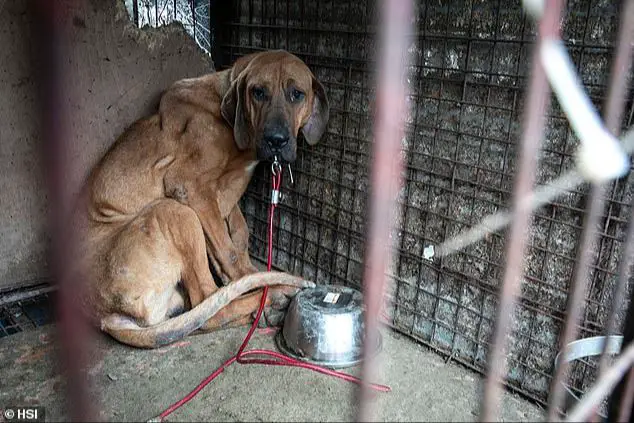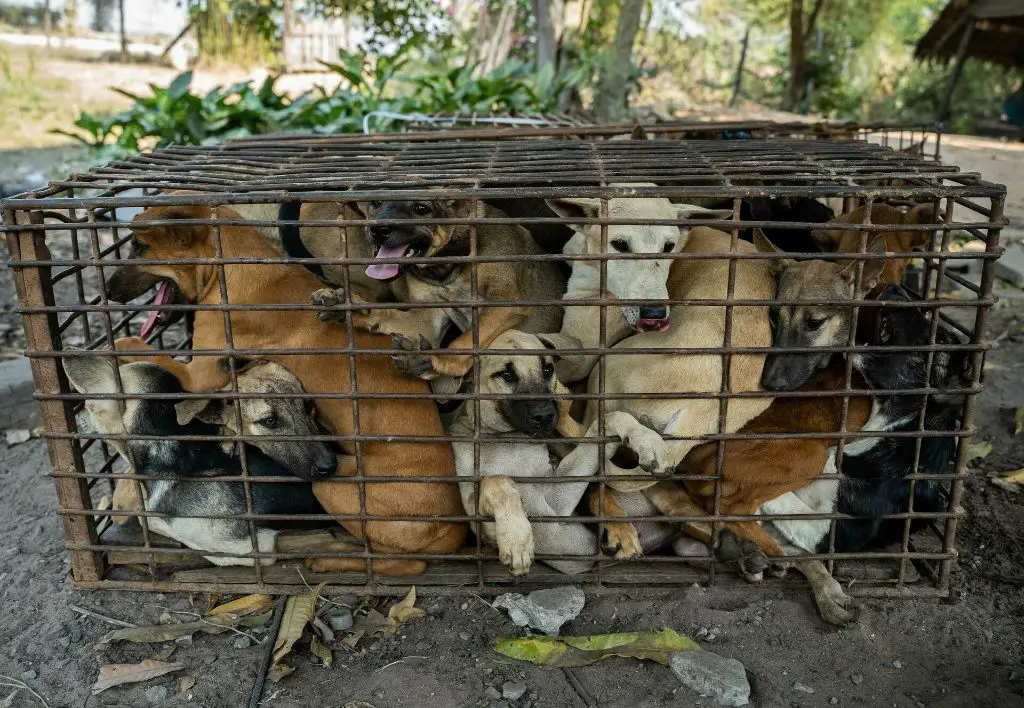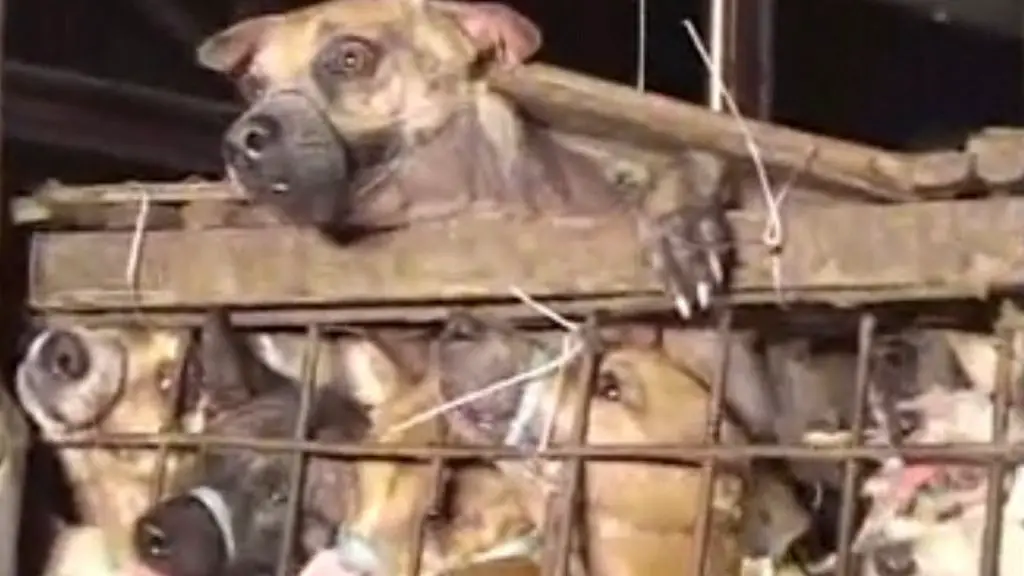Overview of the Dog Meat Trade
The dog meat trade exists in some Asian countries, including China, South Korea, Vietnam, and Indonesia. There is a long history of dogs being raised and slaughtered for human consumption in these regions, dating back thousands of years. However, the scale and prevalence of the modern dog meat industry is difficult to quantify due to the lack of official records and regulation in most areas.
Estimates suggest that in China alone, 10 million dogs are killed for their meat every year. The Yulin Dog Meat Festival held annually in China reportedly leads to the slaughter of thousands of dogs specifically for the event. Though not as widespread as in the past, dog meat restaurants still operate in South Korea today, with over 100 such establishments in Seoul. Surveys indicate 17-30% of South Koreans have consumed dog meat at some point. In Vietnam, approximately 5 million dogs are eaten each year, with hundreds of dog meat restaurants found especially in northern regions.
Though the practice persists, the dog meat trade is declining in countries like South Korea due to changing attitudes and greater affluence. Public opposition in China and Vietnam is also mounting. However, in areas where it remains entrenched, the dog meat industry can be quite lucrative, leading some advocates to argue ending it will require providing alternative livelihoods.
Sourcing of Dogs for Meat
The majority of dogs for the meat trade come from inhumane dog breeding farms. At these farms, dogs are kept primarily in small, dirty cages and provided little food, water, or medical care. The conditions lead to the spread of disease and injuries among the dogs.

Strays make up another significant portion of the dog meat trade. Unclaimed stray dogs are rounded up from the streets and transported to holding facilities. These facilities are similarly overcrowded and unhygienic like breeding farms. Strays suffer from starvation, illness, and injuries.
Some dog meat suppliers also obtain dogs from shelters. Shelters receive government incentives to supply dog meat facilities rather than attempt to adopt out or humanely euthanize unwanted dogs. Shelters supplying the dog meat trade engage in deceptive tactics like advertising dogs as adoptable when they are actually sold to slaughterhouses.
Transport of Dogs to Slaughterhouses
Dogs destined for slaughterhouses are often obtained from illegal dog traders and transported long distances in overcrowded, filthy cages on the back of trucks. The dogs are packed tightly together, and the cages do not provide proper ventilation or allow the animals to sit, stand up, or turn around.

The harsh conditions of transport cause tremendous stress, anxiety, injury, dehydration, and the spread of disease among the dogs. It is not uncommon for 20-200 dogs to be crammed into a single cage on a truck, with each dog having less than 60cm of space. They are forced to urinate and defecate on one another, and some die from suffocation and trauma before even arriving at slaughterhouses.
Transport durations can range from days to weeks, with no food or water provided. Dogs often sustain broken bones, open wounds, and sickness. The extreme crowding also leads to fighting amongst desperate and distressed dogs. Some have resorted to cannibalism. Many dogs die during transport from dehydration, illness, or injuries sustained in fighting.
Slaughterhouse Conditions
Slaughterhouses where dogs are killed for their meat are often very unhygienic and lacking in proper health standards. They are usually makeshift open-air operations set up temporarily just for the festival days. Dogs are typically just piled on top of each other on the dirty floor, and the slaughtering is done out in the open without any concern for contaminating the meat. There is rarely running water to wash away blood or waste, leading to very unsanitary conditions. Proper cleaning and sterilization of equipment is unlikely, risking the spread of bacteria and disease. Many slaughterhouses do not follow basic food safety principles, largely because the dog meat trade operates outside the formal oversight of regulatory authorities. Also, given that the setup is temporary, there is little incentive to invest in proper infrastructure and hygienic facilities. These poor conditions contribute to health risks from consuming dog meat. Overall, the slaughterhouses reflect the unregulated nature of the trade, where animal welfare and public health are not priorities.
Stunning and Killing Methods
There are various stunning and killing methods used in the dog meat trade. These include:
- Electrocution – Dogs are shocked through metal prods or by having their feet placed in electrified water baths. This causes extreme pain, is often ineffective at stunning the dogs, and dogs may remain conscious while being killed.
- Bludgeoning/Beating – Dogs have their heads smashed with metal rods, hammers, or other objects. This frequently does not render them unconscious and inflicts extreme suffering.
- Hanging/Strangulation – Dogs are hung by metal hooks through their necks or choked with wires or ropes. Death can be slow, as dogs struggle and gasp for air.
- Stabbing/Exsanguination – Dogs are stabbed through the heart with knives or have their throats slit to drain their blood. Without prior stunning, this causes immense fear and pain while fully conscious.
Many of these methods are considered inhumane according to animal welfare standards, as they do not quickly render dogs unconscious before slaughter. The brutal methods prolong suffering and trauma.
Pain and Suffering
Dogs in the meat trade often endure immense pain and suffering throughout the slaughter process. From the moment they are captured and transported in cramped, filthy cages, the dogs experience distress, anxiety, and physical discomfort. At slaughterhouses, their suffering intensifies dramatically.

Workers often use cruel restraining methods like stringing dogs up by their legs or necks before slaughter. Being hung upside down causes dogs enormous pain due to their sensitive abdominal organs. The slaughter methods also frequently cause extreme suffering. Dogs are often stabbed repetitively before dying, beaten to death with metal pipes and rods, or having their necks broken. Some are boiled, burned or skinned alive. The extreme pain and extended torture is prolonged and agonizing for the dogs.
Expert opinions conclude that the overall suffering inflicted on dogs in the meat trade is among the worst seen in any animal industry globally. The specific methods used to kill individual dogs maximize fear, trauma and pain before death. There is an utter lack of concern for the dogs’ welfare at any stage of the process. The trade displays a blatant disregard for minimizing the distress, anxiety and agony endured by the animal victims.
Disease Risks
The unsanitary and inhumane conditions of dog meat slaughterhouses present significant risks for the spread of infectious diseases. Many of the dogs slaughtered for meat come from unknown sources, without veterinary screening or vaccination protocols. Sick dogs exhibiting signs of disease are frequently processed for meat consumption along with healthy dogs.
The cramped cages and pens holding large numbers of dogs in filthy slaughterhouses allow for rapid transmission of pathogens between dogs. Additionally, slaughterhouse workers regularly come into contact with blood, feces, and bodily fluids from sick dogs. There is minimal regulation, oversight, or safety precautions taken in most of these facilities.
Several dangerous diseases have been shown to spread through the dog meat trade to humans, including rabies, trichinellosis, cholera and chlamydia. Consuming infected undercooked or raw dog meat and internal organs presents risks for zoonotic diseases. Rabies poses a severe health threat, as it is highly contagious, incurable once symptoms appear, and fatal. While less common, trichinellosis infection can also lead to death if the parasitic worms spread beyond the intestines.
The spread of disease from the dog meat trade has had major implications for public health. Outbreaks originating in unsanitary slaughterhouses have killed people and required mass quarantines of facilities. Due to the lack of transparency in the trade and stigma against speaking out, the number of people affected is likely underreported. Overall, the dog meat trade facilitates the transmission of dangerous diseases that spread to the human population.
Calls to End the Trade
There are many groups actively opposing and trying to end the dog meat trade due to the cruelty involved. Among the most vocal critics are animal rights groups like PETA, Humane Society International, and Soi Dog Foundation, who argue that killing dogs for their meat is unethical and inhumane. Some progress has been made in recent years, largely due to pressure from activists.
In June 2020, the city of Shenzhen became the first city in China to ban the consumption of dogs and cats. This ban came after years of advocacy from animal welfare organizations. Some vendors even agreed to find new livelihoods with support from NGOs like Humane Society International. While the ban was a victory, many regions of China and other Asian countries still allow the dog meat trade to persist.
Despite cultural traditions, views appear to be shifting, especially among younger generations. With mounting pressure from activists and growing public awareness of the cruelty, there is hope the practice will decline and ultimately become illegal across all of Asia. But continued advocacy and change in public opinions will be needed to completely end the brutal dog meat trade.
Cultural Significance
In several Asian countries, the tradition of eating dog meat dates back hundreds of years. Some believe eating dog meat brings good luck, health, and virility. It is considered a warming food that provides energy during the hot summer months. There are also rituals and ceremonies where dog meat is consumed as part of the festivities. For instance, some South Koreans eat dog meat soup on the hottest days of summer, believing it provides stamina to endure the heat. There is a long-held belief that the adrenaline released in dogs before slaughter makes their meat tastier and more nutritious. Dog meat is also offered at celebratory events like weddings in some regions as a demonstration of the host’s generosity and wealth. Overall, dog meat holds cultural significance in certain Asian countries and is deeply intertwined with tradition.
Alternatives and Substitutes

For many communities that have traditionally relied on dog meat as a source of food and income, transitioning away from the trade may seem difficult. However, there are paths forward that allow for improved economic conditions, food security, and animal welfare.
One alternative is shifting to farming and selling other domesticated livestock such as pigs, chickens, ducks or goats. While the initial investment may be higher, over time, regulated livestock farming can provide a more reliable and humane income stream. Farming techniques can be shared across communities to lower barriers to entry.
There is also potential to develop cottage industries around dog breeding for domestic pets, dog training, and veterinary services. With the right support and training, those currently involved in the dog meat trade could become advocates for dog welfare.
Plant-based food businesses present further opportunities to meet protein needs while supporting local economies. Producing and selling vegetarian analogues to dog meat can allow current vendors to maintain their client base during a transition period.
Finally, there are charity programs focused on providing direct assistance with retraining, microloans, and educational support. By empowering communities to move to more sustainable and ethical industries, the dog meat trade can be phased out while protecting livelihoods.